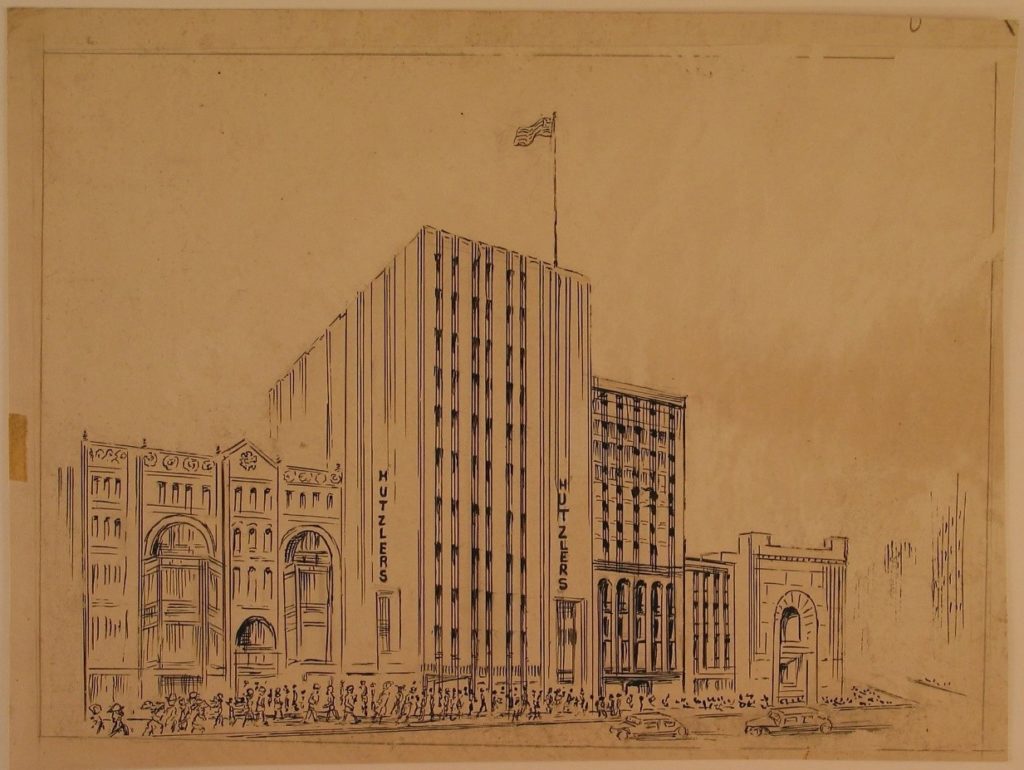Hutzler’s Art Deco Medallion
Marylanders over the age of forty smile brightly and recall fond memories whenever the name “Hutzler’s” is mentioned. Hutzler Brothers Company, established in 1858, was the product of three innovate brothers and dozens of their descendants. During the American Civil War, Hutzler’s experimented with the nation’s first bargain counter, and later, were the first to establish “one pricing”, which replaced the then-standard policy of customers haggling or bidding on goods with the store clerk to determine cost. In 1874, Hutzler’s created a horse-drawn wagon delivery service, and by the turn of the century, offered “same day service” with their fleet of trucks. The North Howard Street store expanded and remodeled numerous times over the company’s first ninety years. In 1952, the company expanded to Towson, Maryland. At the height of their operation, Hutzler’s owned ten stores in and around Baltimore and as far away as Salisbury. After many years of slow and steady decline, Hutzler’s finally closed their doors in 1990.
Last fall, staff in the museum and library worked together to curate The Hutzler’s Experience: How a Small Dry Goods Store Became a Maryland Institution. After announcing this upcoming exhibition, located in the H. Furlong Baldwin Library alcove, staff received dozens of emails and phone calls from Marylanders recalling their Hutzler’s experience shopping with parents and grandparents, sharing vivid details of specific food dishes consumed in the Towson location’s dining room, and offering numerous donations of Hutzler’s ephemera or products. On Facebook, users left hundreds of comments recalling the beloved department store. Among the many donation offers to the museum was a stunning bronze eagle medallion.

On August 25, 1931, Hutzler’s announced the expansion of their store on N. Howard Street. The five-story structure would add 50,000 square feet of retail space to the existing store. It was designed by the office of Baltimore architect Joseph Evans Sperry (1854-1930), who designed the iconic Bromo-Seltzer Tower in Baltimore among many other public buildings in the city. The new structure offered “a restrained modern type of architecture, with a base of iridescent pearl granite ornamented with Allegheny metal, surmounted by shaded brick trimmed with Alabama limestone.” Both the interior and exterior of the existing “Palace” building were remodeled to match this new addition. The new and old structures were connected by a series of enclosed “bridges” built over top of Clay Street. Construction by Consolidated Engineering Company began on September 15 and Baltimore’s first and only art-deco tower was completed by the following holiday season. Matching Hutzler’s history for innovation, the tower was the first building in Baltimore to be electrically welded. In 1942, an additional five floors were added and 50,000 people attended the grand re-opening of the store.

The modern interior matched the grandeur of the exterior. Bronze decorations and eagle motifs were used throughout the store. One of these decorative eagle medallions, now in the collection at the Maryland Center for History & Culture, was once affixed to elevator doors in the tower. In 1984, much of the Howard street store location closed for the final time. By 1985, the interior was gutted and renovated for office space. Most of the original 1930s fixtures were scrapped or sold at auction. After Hutzler’s closed in January 1990, they liquidated all assets and the medallion was sold at auction.
The Hutzler store on North Howard Street still stands today. Above the art deco tower revolving-door entrance, a passerby can still see what is left of the stunning bronze design that once adorned the interior of this important example of Baltimore architecture. The bronze eagle medallion, an extremely rare and important artifact, is now a part of the museum collection and on exhibit in The Hutzler’s Experience: How a Small Dry Goods Store Became a Maryland Institution.
By Harrison Van Waes, Associate Registrar
Sources:
“Hutzler Company to Build Addition: Construction of New Unit at 220-224 N. Howard Street to Begin Next Month.” Baltimore Sun, August 26, 1931, p. 3.
Lisicky, Michael J.. Hutzler’s: Where Baltimore Shops. United States: Arcadia Publishing Incorporated, 2009.

